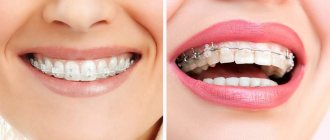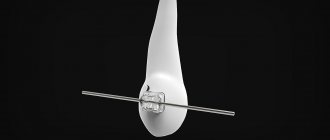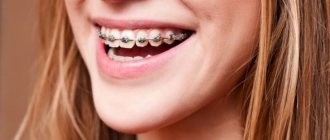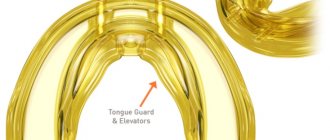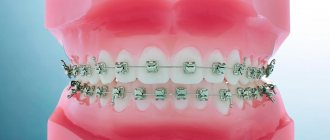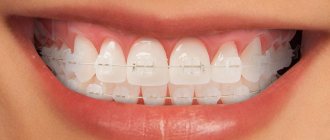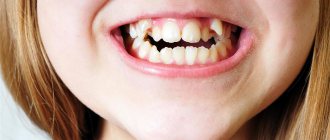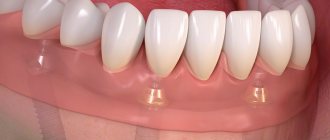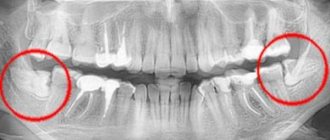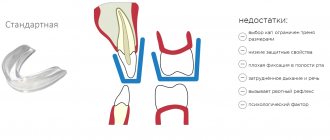History of creation | Working principle | Fixing the system | Withdrawal | Types of braces | Treatment phases | Photos of teeth before and after | Duration of treatment | Brushing teeth with braces | Addictive | Cost of treatment
Braces are a non-removable orthodontic device for the treatment of dental anomalies. Orthodontic treatment is a slow and complex process. The force is created by a metal arc installed in the grooves of the braces. Work productivity increases if the doctor and patient find each other. The design of the bracket system, the doctor’s experience and the patient’s responsibility lead to correct occlusion and stable results.
The material was verified by Anna Rimkevich, senior product manager at Ormco Russia.
A brace system is a tool for correcting a bite in the hands of an orthodontist. Teeth move under the influence of a constant weak force. To speed up the movement of teeth, the doctor uses additional elements: springs, chains, bite pads and elastic rods. After completion of treatment, a correct bite and an aesthetic smile will delight the patient for many years.
The result of orthodontic treatment
The goal of treatment with braces is to form the correct closure of teeth in the sagittal, vertical and transversal planes. In 1972, physician Lawrence Andrews formulated six keys to optimal occlusion in the permanent dentition. When correcting incorrect position of teeth and correcting the relationship between the upper and lower jaw, orthodontists of the 21st century are guided by the signs identified by the researcher:
- fissure-tubercle contact of the molars of the upper and lower jaws;
- crown angulation;
- crown inclination;
- lack of tooth rotation;
- tight approximal contacts;
- parallelism of the occlusal plane of the upper and lower jaw to the true horizontal.
The orthodontist forms the correct occlusion, improves the torque of the teeth and the exposure of the incisors. As a result of treatment, the doctor expands the dentition and creates an ideal smile.
What is an ideal smile? When a person smiles, the anterior teeth, premolars, and mesial surfaces of the first molars are visible. The cutting edges of the incisors and canines of the upper jaw follow the contours of the lower lip and form the arch of the smile.
result of bite correction
Dental braces: what are they?
The design consists of brackets made of metal, ceramics or other materials. The system is attached to the outside or inside of the jaws. All elements are held on a special thin wire.
An orthodontic apparatus is necessary to eliminate pathologies that are associated with incorrect position of teeth. People mistakenly believe that the main purpose of such intervention is the aesthetic appeal of a smile. Doctors do not agree with this and argue that the curvature of incisors, canines and molars is primarily a medical problem, since it often leads to health problems. Food is not crushed enough when chewed, and then poorly digested, as a result of which diseases of the gastrointestinal tract develop.
There are other pathological processes that can only be dealt with with the help of staples. In some cases, extraction is required before installation.
History of the creation of braces
Doctors of the ancient world of the 9th - 6th centuries BC straightened teeth using improvised devices. In 1728, surgeon Pierre Fauchard published a study, one chapter of which was devoted to orthodontics. In the 9th century, the American Edward Engle created the first prototype of the braces system. The scientist invented four devices:
- E-arc gold alloy;
- modification of the E-arch with pins and tubes;
- ribbon arc;
- edgewise braces.
The operating principle of the structures underlies the operation of 21st century braces.
The E-arch, which expands the dentition, was made of a gold alloy and fixed into rings installed on the molars. Each tooth was tied to an arch with wire. Subsequently, Engle refined the design: adjustable tubes appeared on each tooth and pins on the arch. The pins fixed the arch into the slots, the doctor adjusted the pins, and the teeth moved. The system was not actively used in clinical practice, and the E-arm remained an intermediate option.
Later, an American scientist created a ribbon arch. Engle replaced the tube design on each tooth with a vertical rectangular groove. The crowns of the teeth tilted under the influence of the arc, but the roots remained in place. The limitation in the width of the groove and the low elasticity of the arc did not allow the torque to be controlled.
In 1928, Edward Engle designed the edgewise braces system. The scientist compared the geometry of the groove and the arc and replaced the ribbon arc with a rectangular wire. Engle established the slot size of 0.022 x 0.028 inches, which is what 21st century orthodontists use.
Edgewise braces were not wide enough to rotate the tooth under the force of the archwire. To achieve the result, orthodontists installed two braces on the tooth at once. The design formed the basis of ligature systems. With the development of orthodontics at the beginning of the 20th century, the gold alloy from which the arch was made was replaced by stainless steel. The increased rigidity of the steel compensated for the reduced arc thickness. A groove size of 0.018 x 0.025 inches has appeared, which, along with 0.022 x 0.28, is used in practice by orthodontists.
Damon Clear with arc
The evolution of braces
As mentioned earlier, modern braces manufacturers have always taken the design proposed by Engle as a basis. Throughout the 20th century, this mechanism was constantly improved, new ideas and additions to the fastening system appeared. Each subsequent model was better than the previous one, because they tried to eliminate all the previously existing shortcomings.
Modern developments are based on the “prescription” principle, that is, the presence of certain parameters that are included in the algorithm in advance and lead to the correct movement of teeth in the future. Currently, the prescriptions of the following world-famous dental specialists are very popular: Trevisi, Bennett, Damon, Roth and others.
How do braces work?
The system consists of brackets fixed to the teeth, into the groove of which an orthodontic arch is inserted, and additional elements. On the sixth and seventh teeth, the doctor installs buccal tubes to secure the ends of the arch. The force on the tooth depends on the rigidity of the arch and the position of the arch in the bracket groove, the use of additional metal and elastic elements:
- metal ligatures;
- chains;
- springs;
- bite pads made of composite material or bite braces;
- buttons;
- hooks;
- additional arcs;
- elastics.
Damon Q2 with hook
Metal ligatures press the archwire tightly against the bracket, and springs and elastic chains create the force to move individual teeth. Using additional elements of the system, the doctor controls the impact on each tooth.
The arc straightens and pulls the bracket, the force is transmitted to the tooth and causes a process of aseptic inflammation in the surrounding tissues. Osteoclast cells destroy bone at the junction of the root and the alveolar wall. On the other side of the tooth, osteoblast cells synthesize new bone tissue. The balance of osteoblast and osteoclast activity ensures natural tooth movement. Braces direct and accelerate the physiological effect of the force of the arc and additional elements.
arc in groove Damon Q2
The operating principles of self-ligating and ligature systems differ. Self-ligating passive braces provide physiologically adequate force to move teeth due to low friction of the archwire in the closed space of the groove. In self-ligating braces with an active type of ligation, the clip and the arch press against each other. In classic ligature braces, the arch is held tightly in the groove by elastic or metal ligatures.
Plastic braces
All types of braces are connected by a metal arch, due to which the correction is carried out. The design may have plastic locks, screws and other parts, but the arc will still be made of metal. Plastic braces are a good alternative to steel and titanium braces when it comes to aesthetics. However, in terms of efficiency, plastic products are much inferior to metal ones. We list the main advantages of plastic braces:
- low cost;
- stealth;
- short period of adaptation.
Typically, such systems are installed on children or patients with minor defects. However, plastic braces are not suitable for people who play sports or have severe occlusion diseases. This is due to the following disadvantages of plastic braces:
- have low strength;
- are not able to create strong pressure;
- are installed only on the outside of the teeth;
- quickly stain and darken due to eating and smoking.
Plastic braces can be single-colored or multi-colored. If desired, the orthodontist can prepare a design with locks of different colors: blue, red, purple, yellow, etc. Such brackets look unusual. As some people believe, if there is no way to hide your braces from others, make them original.
Fixing the system
Before installing braces, the orthodontist conducts a diagnosis and agrees on a treatment plan. The doctor refers the patient to professional oral hygiene. The procedure is necessary to keep the enamel under the braces intact.
The doctor treats the area of fixation with orthophosphoric acid and applies a primer. The primer contains fluorine compounds that penetrate the enamel. Fluorine molecules are embedded in the crystal lattice of hydroxyapatite enamel and reduce permeability to carious bacteria. Before fixation, the doctor applies light-curing materials, for example Blugloo, Grengloo, Enlight, to the base of the bracket.
Fixation methods
The doctor fixes the braces directly or indirectly. Regardless of the method, installation is painless for the patient.
In the case of the direct method, the orthodontist positions each bracket according to anatomical landmarks, the projection of the root in the bone tissue and the inclination of the tooth manually. Next, the material is illuminated with a polymerization lamp. The patient spends 30 to 50 minutes in the chair.
With the indirect fixation method, the manipulation takes 10–15 minutes and does not cause discomfort to the patient. The procedure consists of several stages:
- The orthodontist manually positions each bracket on plaster models of the jaws;
- transfers braces to a silicone tray;
- applies adhesive to braces;
- During the visit, he moves the elements of the system from the tray onto the prepared enamel and illuminates it with a polymerization lamp.
Fixation of the structure is a key stage of treatment, regardless of the method used. The orthodontist adjusts the width of the teeth and creates an aesthetic smile arch through the correct positioning of each element of the system. Braces work out torque, rotation and angulation. The doctor installs the arc into the slots and releases the patient until the next activation.
Systems for teenagers
Orthodontics in Moscow continues to constantly develop. Anyone can correct their bite, and it is best to do it in childhood or adolescence. And which dental braces to choose, the price of which will be optimal, but at the same time the designs will perfectly perform their functional duties? Here we must be guided by the peculiarities occurring in the body of a teenager.
At this age, a person has a lack of calcium and fluoride. Teenagers often bite their nails, chew gum, and have many other bad habits that lead to a crooked bite. And due to the lack of microelements important for teeth in the body, a person at this age can easily develop an anomaly.
If these indications for treatment exist, the teenager needs to have braces installed on his teeth (the cost of each system varies):
- there are gaps between the teeth;
- the dentition is crooked;
- there is an urgent need for treatment.
Bracket systems are installed, the cost of which depends on their material of manufacture and much more, in several stages. If treatment is required for a child under nine years of age, the doctor performs the procedure and then monitors the child for several years. Then the installation of other braces is carried out during adolescence. The need for this is due to the growth of the jaw.
To make a choice in favor of one or another braces, you need to familiarize yourself with the advantages and disadvantages of each of them. Let's start with metal ones. Such lower and upper braces have the following advantages:
- small thickness;
- quite comfortable to wear;
- the mucous membrane is not injured;
- ease of care;
- strength;
- durability;
- low cost.
As you can see, such a brace system has many advantages; the price in this case is one of the main advantages. But there is one drawback - unaesthetic.
Products made from composite material are quite fragile and therefore short-lived. Ceramic, on the contrary, are highly durable. At the same time, they are aesthetically pleasing, as they are invisible to the eye and are firmly attached to the enamel. But the prices for such braces (Moscow) are quite high. It is also worth noting that they are not picky in their care: you need to look after them very carefully.
Lingual braces, as we have already said, have many advantages. But they can only be installed by adults. The fact is that they are attached to the inside of the teeth, which is an undeniable advantage, but they take a long time to get used to, so teenagers should not use them.
Removing braces
After completion of treatment, the long-awaited moment comes - removal of braces. Using special atraumatic forceps, the orthodontist peels off the bracket from each tooth with one movement of his hand. The patient hears a click and the bracket painlessly moves away from the enamel surface.
Next, the doctor grinds off the remaining glue and polishes the enamel to return the tooth to its original appearance. Grengloo bracket bonding material reduces the excessive impact of rotating instruments during polishing: removing adhesive from the tooth surface does not cause additional damage to the enamel. When there is no green material left, the enamel surface is cleaned.
Doctors from the Department of Orthodontics at the Tabriz University of Medical Sciences in Iran conducted a study and compared the differences in enamel damage after removing two brace designs - with a mesh-type base and with posts.
Researchers have scientifically substantiated the influence of the design of the bracket base on the adhesion strength to the enamel. According to the results of a study by orthodontists, at the base with columns the degree of adhesion to the enamel is higher. At the same time, braces with a mesh base cause less damage to the enamel when removed.
Doctors of the 21st century prefer systems with a mesh base to reduce the number of enamel microcracks during debonding. An example is the Damon Q and Damon Q2 self-ligating braces and the Mini Diamond ligature systems. Ormco's patented bracket base treatment makes removal safe for the enamel.
Damon Q2 with mesh base
Combined braces
Combined braces
When smiling, only the front teeth are visible, and only the upper ones are most noticeable. Therefore, it is not always necessary to place ceramic or sapphire structures on all teeth. To save money, you can install combined braces: put metal on some teeth, and ceramic or sapphire on others. Most often, for the greatest savings, aesthetic braces are placed only on the upper front teeth, although, if desired, you can also install ceramics or sapphire on the lower jaw.
Advantages
- Higher aesthetics compared to all-metal braces.
- Lower cost compared to sapphire or ceramic braces.
- Greater efficiency and versatility than ceramic braces.
- Greater strength - usually high loads fall on the chewing teeth, and the metal braces installed here cope better with them.
Flaws
- Slightly less aesthetics than braces made entirely of ceramic or sapphire - sometimes the structures are still visible when smiling or talking.
- Higher cost compared to metal braces.
- Low effectiveness for severe malocclusions, especially in the smile area.
- Difficult to install - only a highly qualified dentist can correctly install the combined system.
Types of braces
The structures are classified according to the material of manufacture, location in the oral cavity and type of arch fixation. Here are examples of each type of braces.
Material of manufacture
1. Metal braces . Self-ligating Damon Q and Damon Q2 are made from 17-4 stainless steel alloy. In addition to orthodontic products, the high-strength alloy is used in the aviation and chemical industries. An example of metal ligature braces is Mini Diamond and Orthos.
Damon Q2 with lid open
Mini Diamond model
2. Devices made of bioinert titanium alloy . This material is chosen if the patient is allergic to nickel or chromium. An example is the classic Titanium Orthos braces.
3. Ceramic systems . Damon Clear/Clear2 translucent braces are made from durable polycrystalline aluminum oxide (PCA). The period of adaptation to foreign structures in the oral cavity increases, since Damon Clear is larger than metal Damon Q.
translucent Damon Clear
4. Braces made from artificially grown sapphire . Inspire Ice transparent ligature devices have durable wings that do not break off under stress.
transparent ligature Inspire Ice
Location in the oral cavity
The orthodontist fixes the braces vestibularly or lingually. For vestibular localization, the elements are glued to the visible part of the teeth. An example is Damon self-ligating braces. Lingual systems are installed on the dentition from the tongue side, the design is invisible to others. The adaptation period to internal braces is longer than to vestibular systems: it is not easy for the tongue to get used to a foreign structure in the oral cavity. An example is STb braces. Due to the fact that the bases of the braces are made individually according to exact impressions of the jaw, the cost of lingual systems is higher.
vestibular ligature braces Mini Diamond on typodont
Arc fixation type
The arch is attached to classic edgewise braces with elastic and metal ligatures. Ligature braces correct the position of individual teeth and correct complex dental anomalies. The ligatures press the arc tightly against the groove, increasing friction in the system. Example – Mini Diamond and Orthos.
ligature Orthos made of metal
Self-ligating brackets hold the archwire without ligatures: the cover of the structure closes and closes the groove space. In devices with a passive type of ligation, the groove does not interfere with the movement of the arc, the cover is motionless, the arc slides without obstacles, and friction in the system is minimal. The Damon Q and Damon Q2 systems work out the parameters embedded in the braces and start the physiological process of moving teeth.
closed Daimon Q
In active self-ligating structures, the clip puts pressure on the archwire and has a mechanical effect on the entire system. Teeth move in an adequate force zone under the influence of load vectors.
Let's sum it up
The question of why adults need to get braces on their teeth disappears when the patient becomes familiar with the possible consequences of malocclusion. There are many designs that differ in appearance, material of manufacture, visibility to others, cost and other characteristics. Before settling on a specific option, it is necessary to undergo diagnostic tests and consult with an orthodontist. It is likely that wearing the system in a particular case may be contraindicated, so you need to carefully consider the preparatory measures and listen to the opinions of various highly qualified specialists.
Which braces are more profitable to install?
Self-ligating and ligature braces correct the bite and correct complex dental anomalies. Non-ligating systems are more expensive, but the installation of self-ligating structures reduces the number of visits to the clinic. At a lower price for edgewise braces, the patient visits the orthodontist an average of 24 times during treatment, 2.5 – 3 years. When installing self-ligating systems, approximately 12 visits to the doctor are required. The course lasts from 1 to 2.5 years.
Clinic management is often not ready to purchase expensive systems and pay for additional training for orthodontists. Doctor A.V. Tikhonov economically substantiated the advantages of installing ligature-free braces. The orthodontist compared the rate of arch replacement during activation of self-ligating structures and traditional models with ligatures. On average, removing and installing the arch takes 8 minutes. 14 sec. on classic systems and 1 min. 21 sec. – on self-ligating ones. Usually the arches are changed on the upper and lower jaws - the duration of the manipulation is doubled.
treatment on Damon Q2
According to the researcher, taking into account the reduction in treatment time and the number of visits to the doctor, ligature-free braces are more economical for the clinic and the patient. The ergonomics of working with the ecosystem of Damon braces and additional elements reduces the appointment time and the total financial costs of the person visiting the clinic.
What are the advantages of ligature-free braces? And do they exist?
Ligatures are wires or elastic rings with the help of which bracket locks are attached to the arch. In ligature-free bracket systems, the arch is inserted into a special clip, and ligatures are not needed.
Self-ligating braces (also known as self-ligating braces) have been aggressively promoted for some time, causing their prices to rise. However, time and practice have shown that the advantages attributed to such systems are absent (including the myth about the special strength achieved due to minimal friction of the archwire with the bracket locks).
Phases of orthodontic treatment
Orthodontic treatment consists of four stages:
- leveling;
- basic mechanics stage;
- detailing and completion;
- retention.
Leveling
After fixing the braces, the leveling stage begins: the doctor installs round arches. The sequence of arch replacement is standard; if necessary, the orthodontist adjusts or supplements the protocol.
Protocol for replacing wires during treatment with Damon:
- 0.014″ CuNiTi – 10 – 12 weeks;
- 0.016″ CuNiTi – 6 – 8 weeks (intermediate arc if necessary)
- 0.014x0.025″ CuNiTi – 10 – 12 weeks;
- 0.018x0.025″ CuNiTi – 4 – 6 weeks;
- 0.019x0.025″ TMA or SS.
arc in groove Damon Q
0.013″ wires are typically used for severely crowded teeth. The higher the degree of crowding, the more difficult it is to install the arch into each groove. For moderate to mild crowding, the doctor begins treatment with an arc with a cross-section of 0.014″.
Round arches of low rigidity are made from a thermoactive nickel-titanium alloy with the addition of copper. The temperature of the oral cavity activates the physical properties of the metal, and the arc straightens to its original state. The doctor changes the arches in accordance with the treatment protocol. Thanks to the initial arches of low rigidity, the alignment of the dentition occurs, the rotation and position of individual teeth are corrected.
Correctly selected braces torque at the beginning of treatment reduces the number of visits at the final stage.
Basic Mechanics
After the leveling stage, the doctor installs rectangular arches. CuNiTi arches with a cross section of 0.014″, 0.016″ and 0.014x0.025″ are used to completely correct tooth rotations, begin to practice angulation and torque, and create the shape of the dentition. Steel, TMA and nitinol rectangular archwires are used to stabilize the dentition, close spaces, control torque, angulation and rotation.
girl with Damon Clear
During the basic mechanics phase, the doctor sometimes needs to re-bond the braces. This is a standard manipulation that does not cause any difficulties for the orthodontist. The position of the teeth and the vector of force application change, the doctor re-fixes the braces so that the teeth move in the right direction. At this stage, a complex change in the bite occurs; the doctor prescribes elastics. The doctor bends the arches, closes the interdental spaces, makes occlusal linings made of composite material, secures the hooks and installs microscrews.
Final stage
At the final stage, the doctor carries out the details: corrects the position of individual teeth, bends the arches and re-prescribes the scheme for wearing elastics. At the final stage, the doctor uses rectangular TMA 0.019x0.025″ archwires to create detailed bends and then softly transition to 0.019x0.025″ steel archwires, if necessary. A large selection of Damon torque options due to the implementation of the braces prescription allows the doctor to reduce the number of bends on the arches. The orthodontist corrects torque: the vestibulo-oral inclination of the tooth in the sagittal plane. Steel arches with a cross section of 0.019x0.025″ fill the groove, and the bracket fulfills the parameters laid down in the groove.
Retention period
To consolidate the results of orthodontic treatment, the doctor installs a retainer - a metal wire on the palatal and lingual surfaces of the anterior group of teeth. At the age of 25, the formation of the bones of the facial skeleton ends. Up to this age, patients wear a retainer twice as long as treatment with braces. After 25 years, a wire retainer is installed on both jaws for life. Regardless of age, doctors recommend wearing a transparent retention mouthguard at night. If the patient does not follow the doctor's recommendations during the retention period, the teeth may return to their original position.
Consolidation of treatment results in adults
After the braces are completely removed, the teeth are in the correct position, but are not yet secured in it. As a result, if nothing is done, they will quickly return to the original state to which they are already “accustomed”. Therefore, after correcting the bite, it is necessary to wear special structures - retainers. And the period of wearing them is called retention.
There are two main types of retainers—removable and permanent. Removable ones are also different:
- Records. They are made by hand in a laboratory, which poses the risk of human error and bias. This can cause the teeth to move slightly during retention. But such plates are inexpensive and can be easily produced in almost any clinic.
- Mouthguards. They are stamped on a special machine, which allows them to be manufactured as accurately as possible and eliminate the influence of the human factor.
Removable structures are quite comfortable, unnoticeable, and can be removed while eating and brushing your teeth. However, they also have a drawback - the removable design is easy to remove and then forget to put on. The result is the same - the teeth will return to their original places, and you will have to repeat the long and expensive treatment with braces.
Fixed retainers are splints made of special wire that are secured to the back of the teeth with cement. They are convenient because they are easy to wear all the time, but they make hygiene somewhat difficult. Additionally, these fixed structures cannot keep the teeth from moving completely, so they may end up shifting slightly. And the last drawback is that a permanent retainer can only be placed on the lower teeth.
Therefore, dentists more often recommend wearing special removable mouth guards, since they keep teeth from moving much more reliably.
The retention period is quite long - one and a half to two times longer than treatment. That is, if you wore braces for two years, you will have to wear retainers for another three to four years. But this is necessary, otherwise the teeth will shift and eventually the treatment with braces, and then the retention period, will have to be repeated.
How to choose a brace system
The primary task for the patient is to find a doctor with whom a trusting relationship will be established. The orthodontist will conduct a diagnosis, discuss a treatment plan and offer several braces to choose from. The doctor recommends braces based on the patient’s financial capabilities, the complexity of the clinical case and the anatomical features of the dentition. The decision-making is influenced by the doctor’s personal preferences - some specialists work only on self-ligating braces using the straight arch technique, others prefer a multi-loop arch and ligature structures.
young man with Ormco translucent self-ligating braces
Ceramic and sapphire systems are chosen to partially camouflage orthodontic treatment. Bite correction with clear braces takes longer than with metal Damon Q braces due to the higher friction of the archwire and ceramic groove bottom.
treatment with Inspire Ice
Metal braces
Metal brackets for correcting bites are the most common type of braces, which appeared more than 70 years ago. Over time, the design has been modified and modernized, but the principle of its structure has remained the same. Metal braces systems consist entirely of metal, mainly medical steel. This material is very durable, so you can achieve the fastest results with it.
It also has other advantages:
- can correct almost any malocclusion pathology;
- are installed both on the outside and on the inside of the teeth;
- are included in the middle price category (more expensive than plastic, but cheaper than ceramics).
Metal braces also have disadvantages. Among them:
- require adaptation, during which they may rub the oral mucosa;
- affect the patient’s diction;
- low aesthetic properties;
- Not suitable for people with individual metal intolerance.
Often such braces are rejected because they are unsightly. However, in the absence of contraindications, they can be placed on the back side of the dentition.
Metal braces are not only steel, but also titanium. The latter are lighter and more durable, and also have high functionality. In addition, they are biocompatible and therefore do not cause allergies. They are installed for allergy sufferers and patients with gastrointestinal problems. Prices for titanium bracket systems are slightly higher than for steel structures.
Photos of teeth before and after braces
Trust in a doctor consists of many factors: reviews and recommendations from friends, a well-conducted consultation, doctor’s certificates, diplomas and awards, photos of clinical cases “before” and “after” of treatment with braces published on the Internet. Doctors actively maintain groups on social networks and blogs on clinic websites, post videos on YouTube, and post photographs with the results of orthodontic treatment.
deep bite
high crowding, flat profile
moderate crowding, asymmetry
high degree of crowding, open bite, posterior crossbite
case without removal
bilateral crossbite with a high degree of crowding of the anterior group of teeth in the upper jaw
Advantages and disadvantages
Beautiful, straight teeth and a harmonious appearance of the face greatly contribute to the attractiveness and beauty of the face. An attractive appearance makes life easier and opens up great opportunities for balanced psychological development. A person's appearance promotes contact with other people and promotes the feeling of acceptance.
For example, in a study of schoolchildren, it was found that teachers had more positive attitudes towards attractive students than towards their less attractive peers.
In general, improving your appearance can contribute to increased self-confidence and a sense of well-being. Patients receiving orthodontic treatment mention this very often.
There are great differences in the understanding of beauty between different parts of the world. In some Western countries, particularly North America, appearance is extremely important. Physical attractiveness determines not only the initial impression, but also to a large extent social contacts, as well as the chances of being accepted in a group, getting a job, and making friends.
The classic saying “Beauty is in the eye of the beholder” indicates that ideas of beauty are relative. An anomaly that does not hinder one person may be an impossible burden for another.
In America, the film and television industry influenced the concept that it was desirable to have a beautiful “Hollywood” smile, so many people began to pay attention to their crooked teeth and malocclusion and try to correct them even in adulthood.
One of the reasons adults now make up nearly 50 percent of orthodontic patients is that braces have changed significantly in recent years. Adults can now choose from many different types of products, whereas previously only traditional metal structures were installed.
In addition to the psychological benefits, having straight teeth makes them easier to clean, which greatly reduces the risk of tooth decay and gum problems.
Adults' teeth do not move as quickly and painlessly as teenagers' teeth, so some discomfort may occur in the first days. After installation of the structure, some people have speech changes and find it difficult to chew food.
If a patient has metal braces, food can easily get stuck between the gums and teeth.
All the disadvantages of wearing braces can be “survived” if you have a beautiful and even smile in the future.
Alternative to treatment with braces
An alternative to braces is aligners. Transparent hard aligners are used to move teeth in cases where the patient has increased aesthetic requirements. The aligners are made in the laboratory on a 3D printer based on an impression of the jaws. Patients change aligners in the order specified by the doctor. The disadvantage of aligners is the high cost of treatment, but the advantage is the aesthetic component: the aligners are invisible to others. Treatment with aligners takes longer and is suitable for clinical cases of mild to moderate complexity.
The doctor attaches attachments made of composite material to the teeth, on which the mouth guard presses. The teeth move slowly; halfway through the treatment, the orthodontist takes an impression of the jaw and sends it to the laboratory to make new aligners.
Ceramic braces
Braces are also more invisible and aesthetically pleasing if they are made of ceramic. There are many varieties of ceramic materials that differ from each other in shades. The doctor can choose a design that will completely match the natural shade of the teeth. Ceramic braces can only be noticed at close range. If you paint the metal arch white, the staples will become even less noticeable.
The main advantages of braces made from ceramics:
- high aesthetics;
- short adaptation period;
- do not injure the buccal mucosa;
- strength is higher than that of plastic.
The disadvantages of such systems include:
- difficulty in dismantling (may crack);
- darken from tobacco smoke and dyes;
- are not installed on the inside of the teeth;
- high price.
Typically, ceramic braces are chosen by people for whom it is important to hide orthodontic treatment from others.
Partial bracket system
For children in the period of changing temporary teeth to permanent ones, a “2 by 4” system is installed. Braces are fixed on four incisors and two molars. The design is used to close large interdental spaces when there is insufficient space for permanent teeth, early removal of temporary teeth to save space. Often, a 2-by-4 system prepares a child for primary orthodontic treatment with a full brace system. Braces are fixed at 6–7 years of age, when the first permanent molars erupt.
There is no age limit for orthodontic treatment. At any age, braces are firmly fixed to the enamel, and teeth move. Implants or ankylosed teeth in the mouth serve as support and do not move or participate in orthodontic treatment.
When can you do without braces?
Is it possible to avoid braces altogether and use transparent removable aligners? Can! But you should understand that mouthguards can correct only slight deviations from the norm. They will not have any effect on serious defects.
Often, mouthguards are prescribed to children to guide their bite or straighten slightly uneven teeth. This is also true for teenagers, but adults are almost never prescribed treatment with mouthguards, as it does not produce results.
An orthodontist prescribes braces only after 13–14 years of age. Trainers and plates may also be helpful at younger ages. These are specific removable structures that the child wears for several hours a day. They have a positive effect on the bite and help the teeth take the correct position.
Often adults, understanding all the responsibility for future risks, still do not turn to the orthodontist. And this choice also takes place. However, we recommend at least getting a consultation - if you are not ready to wear braces, then at least you will know what difficulties may arise in the future.
Duration of treatment
How long do you wear braces? Treatment with ligature structures averages 2.5 – 3 years. Self-ligating devices are usually worn for 1 – 2.5 years. The duration of treatment depends on the model of braces, the experience of the doctor, the complexity of the clinical case and cooperation with the patient. If you do not wear elastics and do not follow the orthodontist's recommendations, treatment will slow down.
girl with Mini Diamond metal braces
The patient comes to the appointment with the regularity specified by the doctor. At the initial stage of treatment with a self-ligating brace system, the intervals between visits are 8 – 10 weeks. During the basic mechanics phase, the patient visits the orthodontist every month. When installing ligature structures, he comes for activation at least once a month at each stage of treatment.
teenagers with Ormco braces
Other types of braces
There are so-called hybrid or combined designs that combine the features of different types of braces. Examples of such systems are:
- lingual-vestibular;
- metal-ceramic;
- metal-sapphire;
- ligature-self-ligating.
By combining the properties of different types of braces, it is possible to reduce the cost of the structure, improve its aesthetics, increase functionality, etc. This depends on the needs of the patient. These staples are more difficult to make and may take longer to prepare.
How to brush teeth with braces
Regardless of the type of braces and the number of visits to the clinic, a person needs to carefully monitor their oral hygiene. Orthodontic patients follow a diet. Doctors recommend eliminating sticky foods: toffee, halva, nougat, chips, chewing gum, consuming with caution and cutting hard vegetables and fruits into pieces. It is not recommended to drink coffee, red wine and other drinks with dyes. Orthodontists advise avoiding cold or very hot foods: sudden temperature changes damage metal and sensitive ceramics in the oral cavity.
With braces, brushing your teeth becomes more difficult. Using circular movements of an orthodontic toothbrush, the patient removes food debris and plaque from the vestibular surface of the teeth and the space around the bracket. The internal and chewing surfaces are cleaned with a manual toothbrush. The space around the braces and in hard-to-reach places is cleaned with a monotuft brush and dental brushes. Doctors advise using superfloss and irrigator.
It is necessary to brush your teeth three times a day after meals and perform professional oral hygiene in the clinic every 2 to 4 months. By following the doctor's recommendations and maintaining oral hygiene, the patient speeds up treatment.
Braces do not damage the enamel; caries occurs as a result of poor hygiene. The intensity of plaque depends on the type and size of the structure, but the main factor is the patient’s willingness to brush their teeth thoroughly and regularly. Caring for the oral cavity with small self-ligating appliances is easier than with ligature structures. Food remains under elastic and metal ligatures, which leads to the formation of caries.
How to care for your oral cavity?
If you do not take good care of your mouth while wearing braces, your gums may become inflamed. After installation of the structures, it becomes more difficult to brush your teeth, so the duration of this procedure should not be less than ten minutes. At the same time, this must be done after every meal without toothpaste (otherwise it will negatively affect the enamel). If you cannot use a toothbrush, you need to rinse your mouth. This will remove food debris from the system.
It is worth noting that you need to use a special paste and brush. As already mentioned, a simple remedy cannot be used. If you follow this recommendation, you can maintain your dental health. Ideally, you should also visit a specialist at our orthodontics clinic to have professional cleaning done:
- process enamel;
- remove tartar;
- seal fissures.
So, treatment with braces is not only wearing these structures, but also careful oral care.
Getting used to braces
The patient gets used to the braces system in the mouth within a couple of weeks. When the physiological movement of teeth begins, people experience discomfort due to aseptic inflammation of the bone. Patients with self-ligating braces stop feeling pain after a couple of days; when installing ligature structures, the discomfort goes away on the sixth day. The level of discomfort is influenced by the pain threshold, which is individual for each person.
Sometimes, at the initial stage of treatment, nitinol round wires cause discomfort. A glass of cold water relieves discomfort. Due to the physical properties of the thermal activity of the metal, the tension decreases and the discomfort goes away.
The metal of nitinol arcs is in one of two phases. When the temperature changes, the crystal lattice of the alloy changes from the martensite state to the austenite state and back. The doctor inserts a thermoactive arc into the grooves of the braces; under the influence of the temperature of the oral cavity, the arc straightens and gently pulls the teeth along with it. If the discomfort persists for a long time, the doctor prescribes painkillers to the patient.
When you can and cannot wear braces
The use of the system is indicated for malocclusion, crowding, and diastema. People of any age can be treated in this way. There are some restrictions for pregnant women, patients with implants, etc.
Who is contraindicated for installing arches:
- persons with acute immunological and neuropsychiatric diseases;
- patients with diseases associated with blood clotting;
- people with bruxism, serious gum pathologies;
- if you are allergic to metal or other materials used.
Treatment with braces during pregnancy
Pregnancy is not a contraindication for treatment. During pregnancy, women take vitamins that support bone health. Metabolic processes in a woman’s body accelerate, and teeth move faster. Before installing braces, the orthodontist sends the patient for sanitation and professional oral hygiene. To strengthen the enamel, remineralizing therapy is carried out.
Pregnant women, unlike other patients, do not take painkillers to overcome discomfort during tooth movement at the leveling stage. During pregnancy, women often suffer from gingivitis and bleeding gums. Diseases complicate hygiene and are relative contraindications to orthodontic treatment. Sometimes, in order to avoid possible risks, bite correction is postponed until after the birth of the child.
Why do you need to get braces?
Braces for an adult
Typically, braces are installed to improve your appearance. But sometimes malocclusions are almost invisible, so patients do not seek to correct them. But in fact, even a slight malocclusion can lead to serious consequences:
- Caries, gingivitis and other problems with teeth and gums due to uneven distribution of chewing load and injury to soft tissues from improperly growing teeth.
- Pain in the head and jaw due to improper positioning of teeth, compression of joints and nerves.
- Insufficient hygiene due to the fact that certain areas of the teeth cannot be approached due to other dental units.
- Rapid wear of individual teeth, abrasion and even loss.
- Digestive problems due to insufficient chewing of food.
- Inconvenience when using prosthetics in the future.
Therefore, even if there is no desire to make a smile beautiful, or if the bite does not spoil the appearance too much, treatment with braces is still necessary, since it is beneficial for health in the long term.
Removing teeth before installing braces
Sometimes, according to the orthodontist, it is necessary to remove teeth to make room for dentition correction and improve the facial profile. The orthodontist makes the decision about removal after diagnosis and discussion of the treatment plan with the patient. Photometric analysis of the face, examination of X-ray images and diagnostic results help the doctor make the right conclusion.
The complexity of the clinical case affects the need for removal. The choice of prescription in Damon braces in some cases allows you not to remove teeth. To achieve correct occlusion without tooth extraction, the doctor corrects the bite, installs microscrews and performs separation.
How much do braces cost with installation?
Orthodontic clinics use different pricing policies. Pricing is based on the composition of the service and the frequency of payments. In some orthodontic centers, the cost of treatment includes the price of braces, while in others they pay for the system separately.
treatment on the Orthos design
There is an option for a one-time payment for the course of treatment and a scenario in which the patient pays monthly for system activation. For the patient, from the point of view of economic justification, full payment is more profitable, since the final price is not affected by fluctuations in the ruble exchange rate and changes in the price list in the clinic.
The cost of activation of ligature and self-ligating braces is approximately the same. Payment for treatment using classical systems with ligatures consists of 24 visits to the doctor and the relatively low price of the structure. Self-ligating devices are more expensive, but require the patient to go to the clinic only 12 times. Convenience of design, reduction of treatment time, the number of visits to the doctor and the time that the patient spends in the orthodontist’s chair give self-ligating devices qualitative advantages.
The cost of the course is determined by the orthodontist after diagnosis and drawing up a treatment plan.
Head of the St. Petersburg clinic “Full Order”, candidate of medical sciences Tikhonova A.V. compared the effectiveness of treatment under the scheme with a one-time payment “All inclusive” and with payment by visits.
We provide an approximate comparison of ergonomics and financial efficiency of treatment for various price options. Prices are set hypothetically, taking into account the estimated average market prices for St. Petersburg at the time of publication of the manual.
information from the book “Myths about the Damon system” by orthodontist A.V. Tikhonov
The results of the study indicate that the all-inclusive one-time payment scheme is preferable for the doctor and the patient. Payment for results allows a competent orthodontist to quickly complete treatment and increase the profitability of the practice, and the patient to receive a beautiful and healthy smile earlier.
perfect smile with Inspire Ice
Features of bite correction in adults
The rumor that only children can have braces did not appear out of nowhere. Indeed, by about 16–18 years, a person’s jaw stops actively growing, and his bones lose pliability. And if in childhood only a little pressure is enough to correct the bite, in adulthood everything is much more complicated:
- Correcting even minor defects requires at least a year, and sometimes treatment extends for 2–3 years.
- If there is no room for teeth, the jaw cannot be expanded; some teeth will have to be removed to create space for the rest.
- If the jaw is missing teeth or has dentures, this may complicate treatment and require the installation of special structures.
- After treatment, the teeth will tend to return to their original places, so it will take a long time to consolidate the results of the correction.
All this complicates the process, but does not mean that it is completely impossible to correct the bite in adulthood. Adults can wear braces, and although the treatment will be longer and more complex, it will still produce results and remain completely effective.
How to get a tax deduction for treatment with braces
For three years, Russian tax residents can claim a tax deduction for treatment with braces. Taxpayers receive a refund from the state in the amount of 13% of the amount spent on their own treatment, treatment of minor children, parents or spouses. Only the personal income tax that the taxpayer paid to the state for the last year is returned.
Package of documents for the tax office:
- declaration 3-NDFL;
- certificate from place of work 2-NDFL;
- documents from the clinic - a copy of the treatment agreement, a copy of the clinic’s license, a certificate of payment for treatment, cash receipts.
A person who has undergone orthodontic treatment and is claiming a refund must file a tax return by the end of April.
The state returns 13% of the maximum 120,000 - 15,600 rubles. The material is for informational purposes only and is presented for informational purposes. It does not replace consultation with an orthodontist and is not a guide to correcting dental anomalies.
Pain after removal
People who have completed treatment to correct their bite and are concerned about pain often come to our orthodontic center. Let us immediately reassure you that you will experience discomfort for no longer than two weeks. Why does this happen - what causes teeth pain? The fact is that over many years the teeth have become accustomed to the position in which they were before treatment. And after removing the braces, they try to return to the incorrect original position.
A person may experience discomfort for another reason - due to weakened enamel. To get rid of discomfort, the doctor applies a special varnish, gel and paste to the teeth. These products quickly restore the enamel, so the pain goes away.
